The Principles of Judicial Review Was Established in Which Case
Standard five.5: Marbury five. Madison and the Principle of Judicial Review
Explain the Principle of Judicial Review established in Marbury 5. Madison and explain how cases come up earlier the Supreme Courtroom, how cases are argued, and how the Court issues decisions and dissents. (Massachusetts Curriculum Framework for History and Social Studies) [8.T5.5]
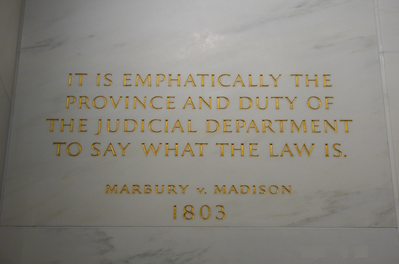
FOCUS QUESTION: How Does the Supreme Court Use the Ability of Judicial Review to Translate the Law?
John Marshall, the quaternary Main Justice of the Supreme Court, was born in Fauquier, Virginia in 1755. His family unit was poor, and every bit a youth, he received fiddling formal education. He fought in the American Revolutionary War, and then studied law from 1779–fourscore. Following that year of study he set up a constabulary practice. In 1782 he was elected to the Virginia legislature. His rapid rise brought him to the Supreme Court, where he served from 1801 to 1835.
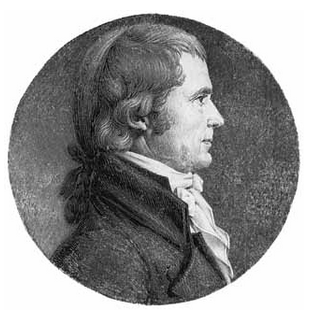
Under his leadership, the 'Marshall Court' shaped the law and government of the United States by testing and defining the powers of the newly adopted U.S. Constitution. He established the principle of Judicial Review whereby the Court has the final say in deciding whether congressional legislation is ramble.
Modules for this Standard Include:
- INVESTIGATE: John Marshall and Marbury v. Madison
- UNCOVER: The Trail of Tears, Chief John Ross, and Supreme Court Cases involving Native Americans
- ENGAGE: Do Supreme Court Dissents Make a Difference to the Law?
- MEDIA LITERACY CONNECTIONS: Reading Supreme Court Dissents Aloud
1. INVESTIGATE: Marbury five. Madison (1803)
John Marshall's Marbury v. Madison (1803) decision formulated the concept of judicial review, giving the judicial branch the final determination on the constitutionality of laws passed past Congress. In other decisions, including McCulloch v. Maryland, Marshall established his view of the power of the federal government over united states and their legislatures.

Watch on YouTube https://edtechbooks.org/-Xof
Suggested Learning Activities
- Blueprint an Infographic or Digital Poster:What was John Marshall's Affect on the Supreme Court
- Explore the resourcesforhistoryteachers wiki folio about John Marshall and Marbury 5. Madison Supreme Courtroom instance.
- John Marshall, Marbury v. Madison, and Judicial Review—How the Court Became Supreme
- Learn Online
- "Marbury five. Madison: An Introduction to Judicial Review" learning plan has a series of interactive activities, primary source documents, and Jeopardy questions for review.
Online Resources for John Marshall and Marbury vs. Madison
- Justice in the Classroom is a teaching resource funded by the John Marshall foundation. Information technology offers a gratuitous online textbook, lesson plans, instructional videos, and allows yous to request a historian or lawyer from the foundation come speak in your grade.
- Marbury vs. Madison: What Was the Case About? | History (video)
- Marbury v. Madison on PBS from its series on the Supreme Courtroom
2. UNCOVER: The Trail of Tears, Principal John Ross, and Supreme Court Cases Involving Native Americans
In the 1830s, the U.s. was transformed by events centered effectually three men: John Marshall, in his final years equally Master Justice of the Supreme Court;Andrew Jackson, the 7th President and John Ross, Main of the Cherokee nation. Their interactions contradistinct the land'south physical landscape and redefined its political culture, replacing the Indian lands of the southeastern Usa with what would become known equally the "Deep Southward" of white plantations with Black slaves, what journalist Steve Inskeep has called "Jacksonland" (2015).
These transformative events began in 1830 with Andrew Jackson's policy of Indian Removal. As part of the Indian Removal policy, native Tribes had to negotiate treaties with the United states government in which they gave upwards their homelands and so moved to new territories (examples: Treaty of Dancing Rabbit Creek, 1830; the Treaty of New Echota, 1835).
The Cherokee people protested the policy, notably John Ross. He envisioned nationhood, not displacement and subjugation for his people (Main John Ross Protests the Treaty of New Echota).
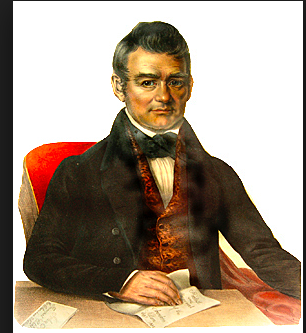
The Indian Removal Act went to the Supreme Courtroom led by John Marshall. In a famous case, Worcester v. Georgia (1832), the Court ruled that the state of Georgia had no jurisdiction over the Cherokees, and therefore could not forcibly remove them from the territory. Read Marshall'southward Opinion in Worcester v. Georgia.
Andrew Jackson ignored the Court, declaring, "John Marshall has fabricated his determination, now let him enforce information technology."
Then "in 1838 and 1839, equally part of Andrew Jackson's Indian removal policy, the Cherokee nation was forced to surrender its lands east of the Mississippi River and to migrate to an area in present-twenty-four hour period Oklahoma" (PBS, 1998, para. 1).
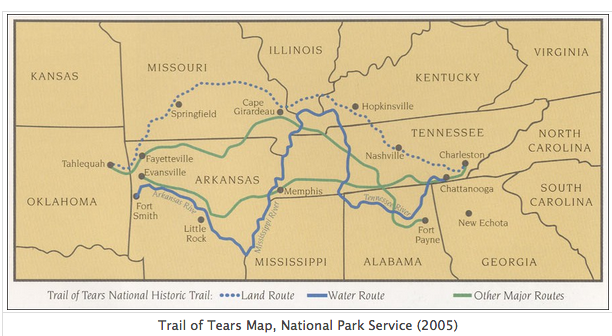
The Cherokee people called this forced journeying the "Trail of Tears." More than 4,000 out of xv,000 of the Cherokees died from the devastations of hunger, illness, and exhaustion on the forced march. It was ane of the darkest moments in United States history. Acquire more from the resourcesforhistoryteachers wiki page: The Trail of Tears.
In 2009, President Barack Obama signed a Congress-passed apology for the Trail of Tears entitled in part, "a articulation resolution to admit a long history of official depredations and ill-conceived policies by the federal government regarding Indian tribes."
Suggested Learning Activities
- Write & Illustrate a People's History
- Create an historically accurate people'southward history using historical accounts of the Trail of Tears from different sources:
- a) What Happened on the Trail of Tears, from the National Park Service
- b) A Cursory History of the Trail of Tears from the Cherokee National Cultural Resource Eye (download PDF)
- c) Two Accounts of the Trail of Tears: Wahnenauhi and Private John G. Burnett, from Digital History
- d) The Human Significant of Removal, main sources from Digital History
- Create an historically accurate people'southward history using historical accounts of the Trail of Tears from different sources:
- Country Your View
- Were Andrew Jackson's actions in defying the Supreme Court an obstruction of justice?
- Do they constitute an impeachable offense?
Online Resources for The Trail of Tears and Native American Court Cases
- Indian Removal Act: Chief Documents in American History, Library of Congress
- Observe the Trail of Tears: A Lightning Lesson from Teaching with Historic Places, National Park Service (2018)
- Supreme Courtroom Case: Cherokee Nation v. State of Georgia (1832)
- Marshall's Opinion in Cherokee Nation v. Georgia
- Supreme Court Case: Fletcher 5. Peck (1810)
- Marshall's Opinion in Fletcher five. Peck
- Justice Johnson's Concurring Opinion
3. ENGAGE: Practise Supreme Court Dissents Brand a Divergence to the Law?
Courts in the Usa operate on the principle of stare decisis (translated from Latin as "to stand by decided matters"). Judges determine cases based on how such cases were previously decided past earlier judges (Walker, 2016). Those before decisions are known every bit legal precedents. A precedent is a rule or guide that has been established by previous cases.
Legal scholars refer to certain rulings as super precedents which are "ramble decisions in which public institutions have heavily invested, repeatedly relied, and consistently supported over a significant menstruum of fourth dimension"(quoted from Constitution Daily, October 20, 2020, para. 7).
On notable occasions, however, the Court changes its before interpretations in what have become known equally landmark cases.The 1896 Plessy 5. Ferguson "separate but equal" decision, for example, was reversed by the Brown v. Board of Education determination outlawing racial segregation in schools in 1954. Brown v. Board of Educational activity is now considered a super precedent.
Landmark cases tin alter fundamentally how society operates. In Gideon v. Wainwright (1963), the Courtroom held that anyone charged with a crime is entitled to gratuitous legal representation, a major change in granting full rights to those defendant of a crime. In Roe 5. Wade (1973) the Court stated that laws that restrict or deny a woman'south admission to abortion are unconstitutional. The police force is never stock-still, but rather it is always evolving as attitudes and situations alter over time.
Cases before the United states of america Supreme Courtroom are decided past a bulk vote of the justices who author a written opinion explaining their reasons. Sometimes there are concurring opinions every bit well. The justices who voted in the minority also accept the opportunity to explain their votes through what is called a dissent or dissenting opinion.
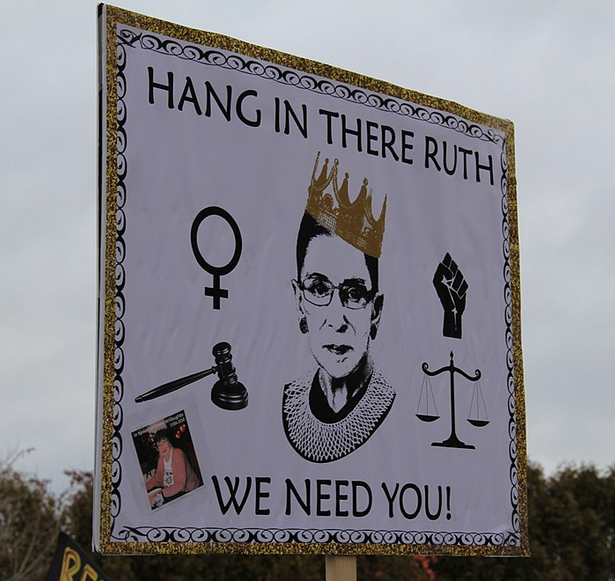
Montana by Montanasuffragettes and licensed CC BY-SA 4.0)
"I Dissent" is a powerful statement of politics and law. Dissents constitute a counter-narrative to the majority stance that can, over time, lead the Courtroom and public opinion in new directions. As Ruth Bader Ginsburg stated:
"Dissents speak to a hereafter age. It's not simply to say, 'My colleagues are incorrect and I would do information technology this way.' Just the greatest dissents do become court opinions and gradually over time their views get the ascendant view. And so that'south the dissenter's promise: that they are writing not for today but for tomorrow."
There are many historic dissents in Supreme Court history: Benjamin Robbins Curtis in the Dred Scott instance; John Marshall Harlan (known historically as "The Great Dissenter") in Plessy v. Ferguson (Harlan wrote: information technology is wrong to let us to "regulate the enjoyment of citizens' civil rights solely on the basis of race"); Oliver Wendell Holmes in Abrams five. United States; Robert Jackson in Korematsu v. United States; and Harlan Fiske Rock in Minersville School District v. Gobitis. All were statements in support of personal freedoms and liberties. Before his death, Justice Antonin Scalia was a frequent dissenter, supporting an originalist interpretation of the Constitution.
In the grade of her career on the Court, Ruth Bader Ginsburg (RBG) authored many notable dissents, including in a gender discrimination instance brought by Lilly Ledbetter against the Goodyear Tire & Safe Visitor in 1999. A lower court had awarded Ledbetter 3.8 1000000 in dorsum pay and damages, reflecting 19 years in which she worked and earned lower pay than male person co-workers. In a 5 to 4 vote, the Supreme Court overturned the lower court decision which occasioned Ginsburg's historic 2007 dissent (listen to the audio of her dissent).
Justice Ginsburg's ideas helped lead to the passage of the Lilly Ledbetter Off-white Pay Human activity of 2009.
Yous can learn more near the career of Justice Ginsburg in the flick book, I Dissent: Ruth Bader Ginsburg Makes Her Marker (Debbie Levy, Simon & Schuster Books for Immature Readers, 2016).
Media Literacy Connections: Reading Supreme Court Dissents Aloud
Eachterm (the fourth dimension period from the first Monday in October to late June/early July), the Usa Supreme Court decides between lxx and fourscore cases and in that location are dissents in 60% of them. A dissent or dissenting opinion is a statement by a estimate expressing and explaining disagreement with the Court's majority opinion.
Occasionally, but notably, these dissents are read aloud from the bench by a dissenting justice. The impacts of a read aloud can be far-reaching.
The late Justice Ruth Bader Ginsburg (RBG) produced one of the Court's most dramatic dissent read alouds in the famous gender pay discrimination case,Ledbetter v. Goodyear Tire & Rubber Company (2007).
In 1999, Lilly Ledbetter sued her employer, Goodyear Tire & Rubber Visitor on the grounds that she had been receiving lower pay than her male person coworkers for 19 years. She won a $3.8 1000000 settlement in federal courtroom. Nevertheless, the Supreme Courtroom (past a 5 to 4 vote) reversed that decision, saying Ledbetter's merits had not been made within a 180 day fourth dimension charging menses.
Ginsburg, the just woman justice on the Courtroom at the time, dissented passionately, declaring that the Courtroom "did not comprehend or is indifferent to the insidious way in which women can be victims of pay discrimination."
Two years later, President Obama signed the Lilly Ledbetter Fair Pay Act of 2009 that reversed the Supreme Court's determination. Ginsburg's dissent is credited as providing the political and social momentum needed to enact this major milestone in the quest for equal rights for women.
In this activity, you will listen to Ruth Bader Ginsburg'south famous dissent spoken aloud and consider how hearing a dissent spoken direct by a Supreme Court justice might influence people's thinking.
- Activeness: Evaluate the Impact of Spoken Words in Supreme Court Dissents

Sentinel on YouTube https://edtechbooks.org/-FfoM
Suggested Learning Activeness
- Write a Dissent
- Dissent writing illustrates the ability of words and the importance of a well-reasoned arguments in presenting one'south ideas.
- Individually or in groups, write a dissent to existing school or community policies and practices that touch students and their families.
Online Resources for Dissents
- How to Read a U.S. Supreme Courtroom Stance, American Bar Clan, Nov 27, 2018
- The Power of a Supreme Court Dissent, David Cole, The Washington Post (Oct 29, 2015)
- Looking Back: Famous Supreme Courtroom Dissents, from the National Constitution Eye
- John Marshall Harlan'due south Dissent in Plessy v. Ferguson (1896)
- Oliver Wendell Holmes and the Well-nigh Famous Dissent in American History, The Atlantic (April 10, 2013)
- Abrams 5. United States (1919), Justice Holmes Dissenting
- 5 Opinions from Justice Antonin Scalia That Are Worth a Read, NPR (Feb 13, 2016)
- Lilly Ledbetter: RBG'due south Dissent in Landmark Case Still Gives Me 'Chills'
Standard five.5 Conclusion
"The Constitution means what the Supreme Court says information technology means," said Professor Eric J. Segal (2016) in the Harvard Law Review Forum (2016). INVESTIGATE examined the impact of John Marshall, the Chief Justice who established the power of judicial review for the Supreme Court. UNCOVER reviewed at the Trail of Tears, a seminal event in First American history when the power of the federal government'due south President was pitted against Indian tribes and the Supreme Court itself. ENGAGE asked how dissenting opinions past Supreme Court justices can make a difference in how the police is understood and applied.
Source: https://edtechbooks.org/democracy/judicialreview
0 Response to "The Principles of Judicial Review Was Established in Which Case"
Post a Comment